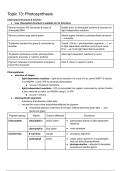Summary
CIE A Level Biology 9700 Topic 13: Photosynthesis Summary Notes
- Institution
- CIE
Clear, concise, effective summary notes covering all points in Topic 13: Photosynthesis of the new 2022-24 CIE A Level Biology syllabus. A must-have revision tool that helped me achieve an A* in A-Level Biology.
[Show more]



